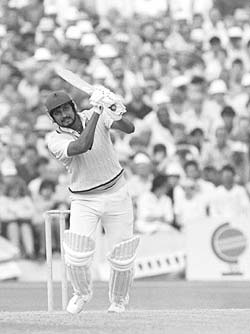Underdogs India shocked the cricketing fraternity when they emerged triumphant at the 1983 World Cup. Many believe that India were plain lucky in the final, as the West Indies faltered badly while chasing a lowly target of 183 in 60 overs.
However, batting ace Sandeep Patil insists it was a case of self-belief and committment to the cause rather than anything else that India achieved the momentous feat.
Patil, himself, was a revelation with the bat and helped stitch important partnerships in the middle order whenever needed for a tally of 216 runs in eight matches. His most memorable knock was the cracking half-century (51 off 32 balls) in the semi-final against England that helped India enter the title clash in a positive frame of mind.
Rediff.com caught up with the 51-year-old to learn more on how 'Kapil's Devils' pulled it off.
India beat the West Indies for the first time at Berbice [in an ODI series] just before the World Cup. Do you think that win gave the team the required momentum?
Well, unfortunately, I missed out on that tour because I was nursing an injury. But, definitely, beating the West Indies anywhere is great, because they ruled world cricket in that era.
I think beating the West Indies in the West Indies is where the confidence came and India carried on that confidence to the World Cup.
India also won its first match in the 1983 World Cup, beating two-time champions West Indies. How big a boost was it?
Of course, beating the West Indies, particularly at the World Cup, was great, especially because India's record was so poor prior to the 1983 World Cup.
So, definitely, winning the first match and getting a head start was a boost.
Do you think that win gave India the confidence that also helped you guys in the final, despite posting a modest 183?
It is very easy to say that now because we won the World Cup. But we kept on trying. It was a sincere effort; we had self-belief and everybody played to their potential. I think that was the key.
Also, we never panicked, right from the first match to the final. Our captain, Kapil Dev, who led the team so well, never put pressure on anybody, be it a batsman, bowler or fielder.
And everybody contributed.
Please continue
In the fielding department, I think, Kris Srikkanth, Yashpal Sharma and Syed Kirmani were outstanding. Sunil (Gavaskar) was excellent in the slips. In the bowling [department], Kapil led the attack and was well-supported by Roger Binny [who was the highest wicket-taker in the tournament], Jimmy (Amarnath), Ballu (B S Sandhu) and Kirti (Azad) and Ravi (Shastri) at times.
In batting, we all played around Jimmy Amarnath. He was the sheet anchor, the pillar of strength, but we all played our parts. It was a consistent performance throughout the tournament by all 14 members.
 How would you rate Kapil Dev as a captain?
How would you rate Kapil Dev as a captain?
The way he batted, the way he bowled it was a total positive approach that certainly helped. That's why he was the captain.
Coming to your own batting, that knock of 51 (off just 32 balls), against England in the semi-finals, must be one of your memorable innings?
I remember that because I have very few memorable innings. It is really easy to remember that particular innings because that put India in the final. But how can you forget the partnership between Jimmy and Yashpal? They laid the foundation.
So, whether it was me, Kirti or Kapil, who followed, we knew we only had to finish. Of course, we finished in style!
The asking rate was definitely not easy, because in those days [it had climbed over six] five-plus was considered impossible; but we managed it. Being in good form helped. I also had a good knock earlier that year at Old Trafford, 129 against Bob Willis. So, same bowlers, same team and same wicket, that helped me.
Would you consider the World Cup win as India's biggest triumph?
I would say it was 1971. Ajit Wadekar's team put India on the world map. Winning the World Cup was definitely special. We also won the World Championships in 1985, the Asia Cup and in Sharjah. But people still give more importance to that World Cup win.
Photographs: Getty Images






